#Manduca quinquemaculata
Text
So my sister found this five spotted hawk moth (or a Manduca quinquemaculata) in my bearded dragons cage and he’s super cute (and very soft I gave him a few pets cause I found him too adorable not to pet him) and I’m having a hard time deciding whether I want to name him Copia or Terzo. What do you guys think I should name him?

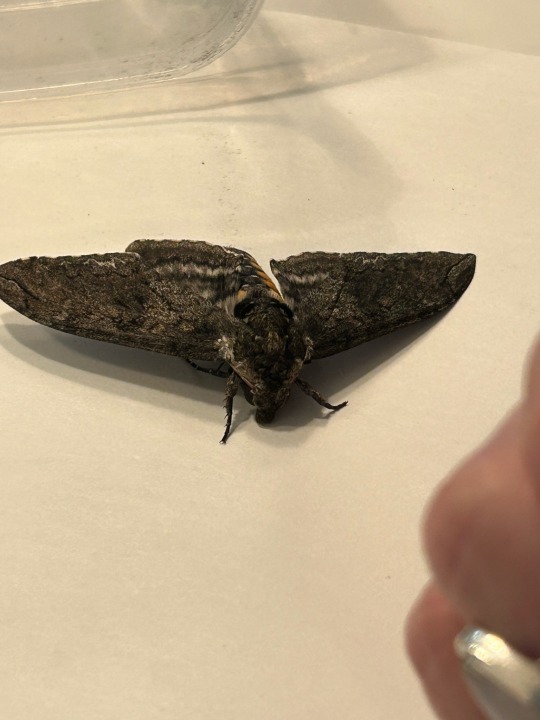
#digital artist#gay artist#oc artist#fanfic writer#ghost#the band ghost#ghost terzo#ghost phantomime#ghost bc#ghost copia#ghost the band#papa terzo#terzo emeritus#terzo#cardinal copia#papa copia#papa emeritus iii#papa emeritus iv#moth#five spotted hawk moth#moth lover#he’s so cute and pretty I’ve been freaking out about it all day
55 notes
·
View notes
Text
Now that I've finally gotten around to finishing my saved for later projects, I would like to share my insect pinning magnum opus. A shadow box full of nearly every insect I've ever worked on!
(Close ups and image descriptions below the keep reading. Image description also includes all speculative ids that are present on the labels you can see in the photos, so if you're curious as to what something is check there!)
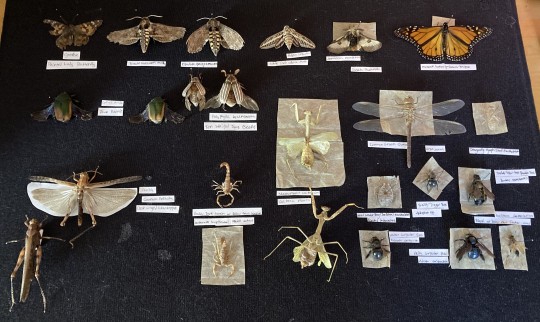
I started this when I was still super new at the hobby, so some specimens are better preserved than others, but it's nice to see my improvement with all of them together. It's also nice to see a sort of representation of all the insect life around me with them.
A lot of these are also in rough shape since I scavenge all of my specimens (usually dead or dying), or am given scavenged specimens, and very few of them were raised or captured for the purpose of pinning. I think this definitely adds to the fun of the hobby though, since each one has a pretty unique story about how it was found or acquired.
Most ID's are also still subject to change and some are still speculative, since I do all my own research for them and am definitely not perfect.



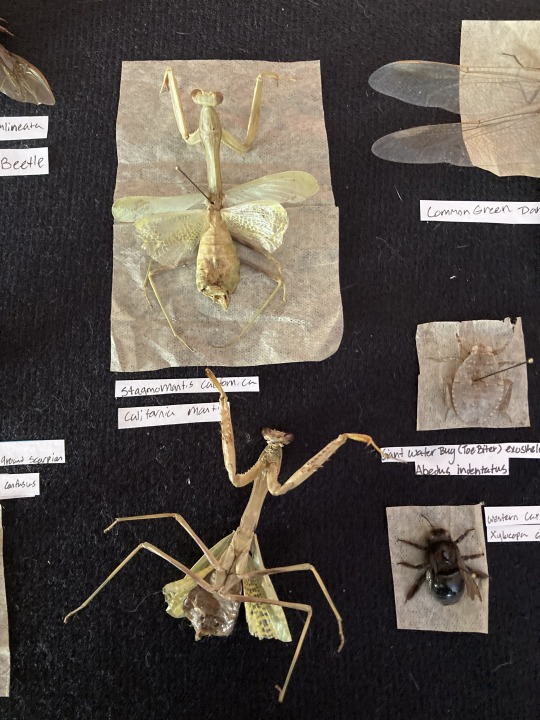
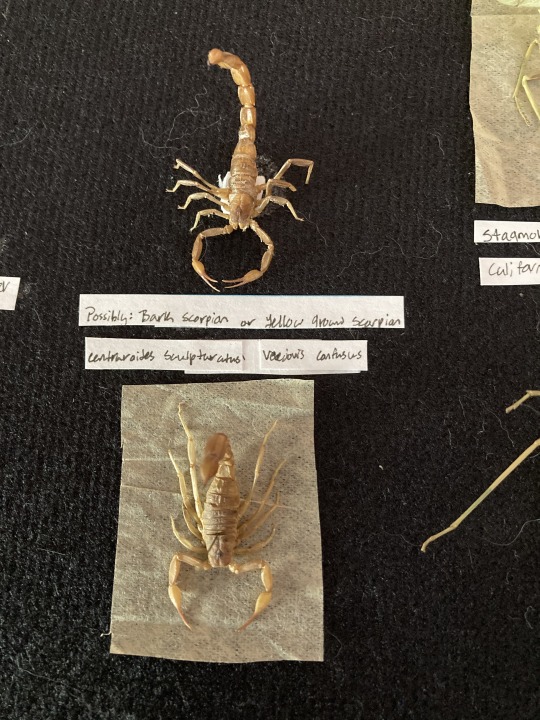

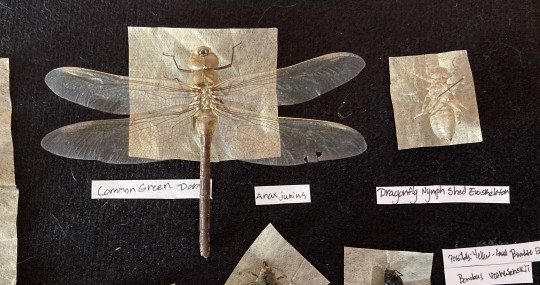
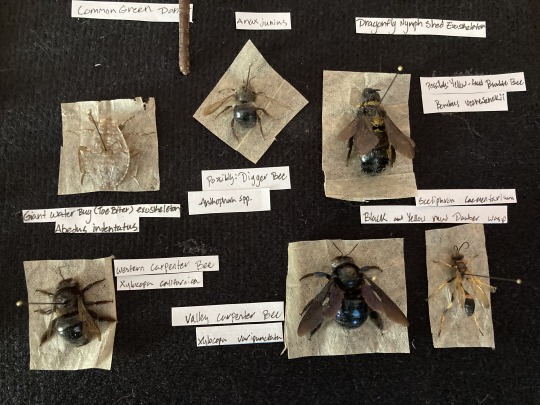
[Image ID: One wide shot image of a black board with various insects displayed on it, with small hand written labels next to, above, or below each specimen. 8 images follow as close ups of each group of specimens. The first displays a painted lady butterfly, scientific name cynthia, next to two tomato hornworm moths, scientific name Manduca quinquemaculata, with two june beetle, scientific name cotinis nitida, and ten striped june beetle, scientific name polyphylla decemlineata, underneath. The second displays a white lined sphinx moth, scientific name hyles lineata, next to a nevada buckmoth, scientific name hemileaca nevadensis, and a monarch butterfly, scientific name danaus plexippus. The third displays two clear winged grasshoppers, scientific name camnula pellucida. The fourth displays two california mantis, scientific name stagmomantis californica, one is displayed on its back, the other on its belly. The fifth and sixth display two views of two scorpions, both either yellow ground scorpions, scientific name Paravaejovis confusus, or arizona bark scorpions, scientific name centraroides sculpturatus. The seventh displays a common green darner dragonfly, scientific name anax junius, and a shed dragonfly nymph exoskeleton. The eighth displays the exoskeleton of a giant water bug, scientific name abedus indentatus, next to a digger bee, scientific name anthophora spp, with a yellow faced bumble bee, scientific name bombus vosnesenskii, next to the digger bee. Below these three specimen are two other bee specimen, a western carpenter bee, scientific name xylocopa californica, and a valley carpenter bee, scientific name xylocopa varipunctata, as well as a yellow legged mud dauber wasp, scientific name sceliphron caementarium. End ID]
#entomology#insect pinning#scorpion#butterfly#mantis#bee#moth#insect tw#drowsy draws#(the drowsy draws tag applies to all my art. even if it's not a drawing per se. so this goes here too!)
19 notes
·
View notes
Text
Yet some species of moth with long, specialized proboscises are uniquely adapted to suck the nectar from the flowers of the datura, a plant of the Solanaceae family that is notoriously hallucinogenic for human beings. In Arizona the Manduca quinquemaculata moth lives on a diet of Datura meteloides nectar and in doing so contributes to the pollination of its flowers.
Only after countless observations did researchers realize that these moths appeared to be drunk once they had sucked the nectar. Observation of their intoxicated behavior had slipped easily through the cracks—first because it occurs at night, when the datura opens the corollas of its blossoms, and second, because botanists and entomologists who take the trouble to spend their nights on the ground beside datura plants are primarily interested in identifying the pollinating insects and capturing them while they are still inside the flowers.
But some researchers reported that after the moths suck the nectar of several flowers, “They seem clumsy when they land on the flowers and often miss the target and fall onto the leaves or the soil. They right themselves slowly and awkwardly. When they take to flight again, their movements are erratic, as if they were confused. But the moths seem to like this effect and return to suck more nectar from those flowers (Grant and Grant 1983, 281).”
The nectar of this type of datura probably contains the same psychoactive alkaloids present in other parts of the plant, which is harvested by human beings for its hallucinogenic properties. The Grants hypothesize that this nectar, intoxicating as it is to the moths, may function as a kind of recompense offered by the plant to the insects that pollinate its flowers. Their resulting behavior, however, can prove extremely dangerous to the moths: to lie, even briefly, in a daze on the ground or to fly slowly and awkwardly is also to fall easy prey to avid predators—other nocturnal insects, reptiles, and amphibians—that have learned to wait under the datura plants for their complacent victims.
[...]
The chemist Paul Lindner (1923), an expert on fermentations, reported that the larva of the carpenter moth (Cossus cossus), stag beetles, and squirrels all greedily drink the fermenting sap of oak trees and get drunk on this sort of natural beer.
Lennig writes of this that “stag beetles first begin to rustle and click; then they sway and fall off the tree, trying awkwardly to stand back up, now on one leg, now on another—rolling over onto their backs every time—and finally they yield to their drunkenness and sleep it off (Reko 1996, 182).”
-- Samorini Giorgio, Animals and Psychedelics: The Natural World and the Instinct to Alter Consciousness
32 notes
·
View notes
Text
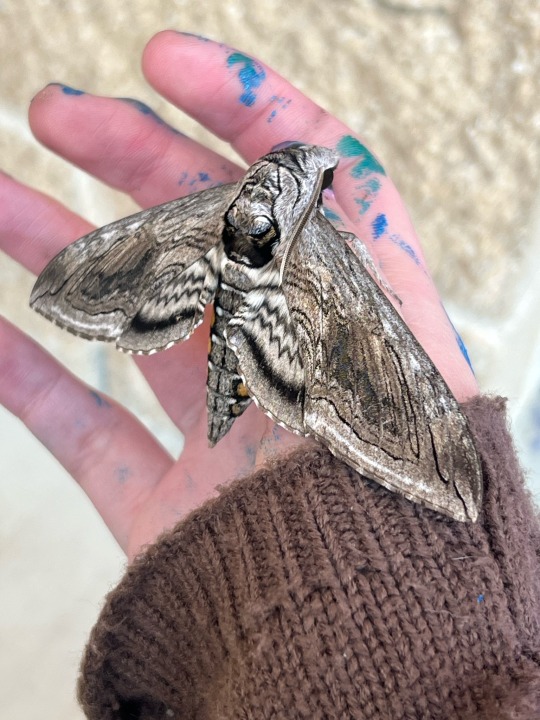
five-spotted hawk moth (Manduca quinquemaculata) :3
4 notes
·
View notes
Note
That caterpillar might be a tomato hornworm (Manduca quinquemaculata)
They do look similar! If they tend to grow a lot then I think this one's a pretty good bet actually.
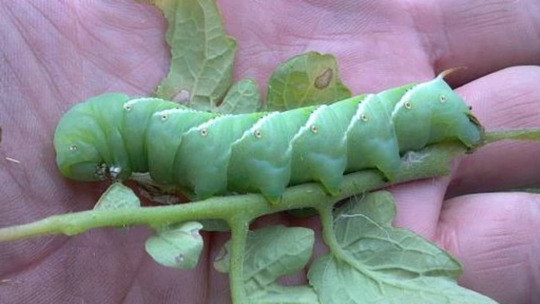
some others also suggested hawk moths so I'm betting on a great ash sphinx moth or something similar, I do see adult ash sphinxes around here a lot

12 notes
·
View notes
Text
Manduca Quinquemaculata
https://entnemdept.ufl.edu/creatures/field/hornworm.htm
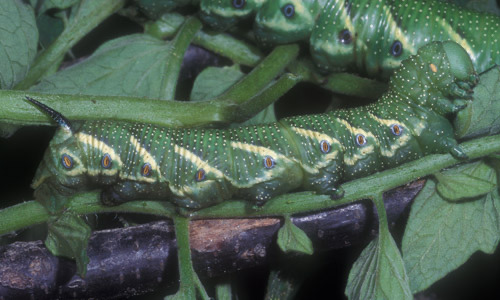
Late instar larva of the tomato hornworm, Manduca quinquemaculata(Haworth).

Pupa of Manduca quinquemaculata
Adults: Adults of the tomato hornworm are commonly referred to as five-spotted hawkmoths (Figure 4), referring to the pairs of orange-yellow markings along the sides of the abdomen. These moths are heavy-bodied and relatively large, though they are very capable flyers. Their graceful, agile flying behavior and overall body shape is reminiscent of a hummingbird, and moths in the Sphingidae family are sometimes referred to as hummingbird moths (Cranshaw 2004). The adult moths nocturnally visit flowers, feeding on nectar.

Adults fly at dusk, and females deposit eggs singly on the upper surface of host plant leaves

Parasitized hornworm
General predatory insects such as lady beetles and green lacewings often prey upon the egg stage and on young caterpillars.
Another important predator is the paper wasp, Polistes spp. This common wasp feeds on many types of caterpillars including those found in gardens.
Tomato hornworms are also parasitized by a number of insects.
One of the most common is a small braconid wasp, Cotesia congregatus.
Larvae hatching from wasp eggs are laid on the hornworm.
The wasp larvae feed on the inside of the hornworm until the wasp is ready to pupate.
The cocoons look like white rice protruding from the hornworm's body.
If you see this happening, leave the hornworms in the garden to allow the adult wasps to emerge.
These wasps kill the hornworms when they emerge from the cocoons.
Then the wasps look for other hornworms to parasitize.
1 note
·
View note
Text
How To Identify And Getting Rid Of Tomato Hornworms
How To Identify And Getting Rid Of Tomato Hornworms
By David Wall, Mt. Pleasant Master Gardener
Anyone who has grown tomatoes knows the dangers of the tomato hornworm (Manduca quinquemaculata). It is also known as tobacco hornworm with the only distinguishable difference between the two being the color of the horn, which resembles a stinger (black for tomato and red for tobacco). This caterpillar, which can grow to 3-4 inches virtually…

View On WordPress
0 notes
Text

*chomp* munch* *munch*
2 notes
·
View notes
Text

I found four of these suckers on my tomatoes today. No sign of the useful parasitic wasps, so I gave them to the chickens. I'll have to be on the lookout for more - they can do some serious damage.
#tomato hornworms#manduca quinquemaculata#bugs#garden pests#my garden#vegetable gardening#garden2020
12 notes
·
View notes
Photo

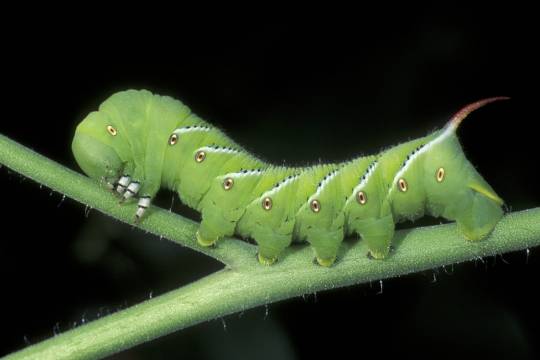
What do these two creatures have in common? They’re ... the same creature. The Tomato Hornworm, bane of every gardener, joy of every chicken, horror of everyone creeped out by the effects of parisitoid wasps. If it survives the barrage of angry gardeners, hungry chickens, and sticky wasp eggs long enough to pupate, it will hatch out into a Five-Spotted Hawk Moth, which is something really beautiful. The soft, cryptic gray fluff? The striking but tasteful row of orange blotches? The mysterious dark eyeline? The elegantly tapered wings? The perfect size, a whole handful of moth. It’s just so wonderful. I almost feel like it’s worth it to sacrifice a tomato plant just to see that glorious moth. Perhaps one could be captured and raised indoors, like I have done with Black Swallowtails... the thought is tempting.
On another note, I recently discovered the Latin name for this species: Manduca quinquemaculata. “quinquemaculata” means “five spots” and presumably refers to the five fine orange spots on the side of the adult, also referenced in the moth’s common name, “Five-Spotted Hawk Moth.” I am curious as to whether the number of these spots is distinct to the species; considering the focus its names places on the number, I would guess so. But is this a useful identifying characteristic? Are there other hawkmoths that look very similar except for having six spots, or four? What might their caterpillars look like? What do they eat?
This Latin name also reminds me how much I love the Latin word for five - Quinque, pronounced “kwin-kway.” It’s just such a cute word, and so different from most other number names, which are generally not nearly as cute. Even other Romance languages’ words for “five” pale in comparison. It also makes me think about Tokyo Ghoul (which I am reading right now - it is very good), and the “quinque” weapon that ghoul investigators use. There’s no way that they didn’t get that name from Latin, but I have to ask, why? It seems an odd choice of etymology. What does the quinque weapon have to do with the number five? I guess it could represent the number of types of kagune that they can be made of, but there are only four of those. Perhaps there is some hidden meaning that I have to read further to find out... foreshadowing a fifth type of kagune, or at least a fifth type of quinque? Who knows, I am ... definitely overthinking it.
#tomato hornworm#tobacco hornworm#five spotted hawk moth#Manduca quinquemaculata#moths#caterpillars#Sphingidae#photos not mine#rambling#quinque#tokyo ghoul#bugs
4 notes
·
View notes
Photo

Tomato hornworm (Manduca quinquemaculata)
104 notes
·
View notes
Photo
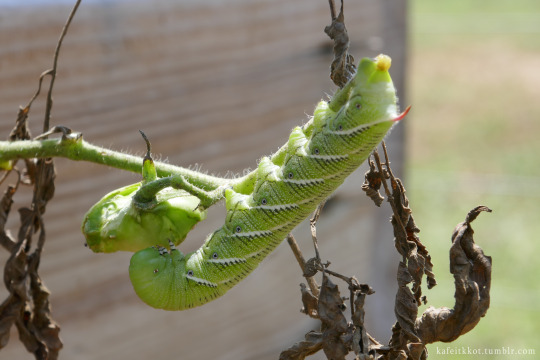

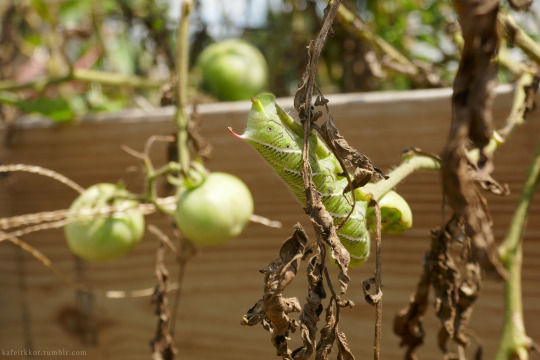
tomato hornworm caterpillar 09.05.21
I noticed a few of these caterpillars on my tomato plants a couple days ago. you can see all the tomato that its already eaten in the first two pictures.
↳ do not edit or reupload.
#manduca quinquemaculata#five spotted hawkmoth#nature#photography#caterpillar#bugs#garden#gardening#nature photography#the pictures do not match up#sorry I remembered to change the white balance later#the last photo is slightly truer to real life#although the atmosphere is truer in the first two
0 notes
Photo

Big boys. ♪
#insects#bugs#my pictures#my pets#hornworm#tomato hornworm#i remember when these guys were no bigger than my nail#Manduca quinquemaculata
22 notes
·
View notes
Photo
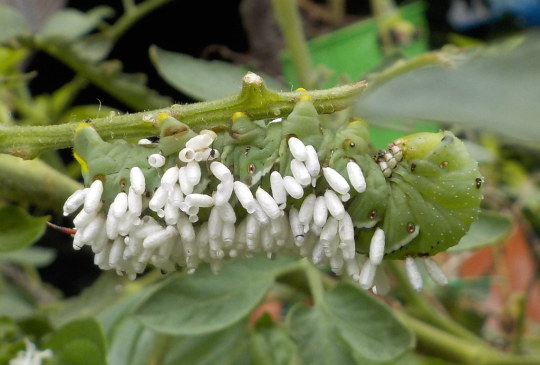
Cotesia congregatus Wasp Eggs Slowly Devouring the Host Tomato Hornworm (Manduca quinquemaculata)
24 notes
·
View notes
Text
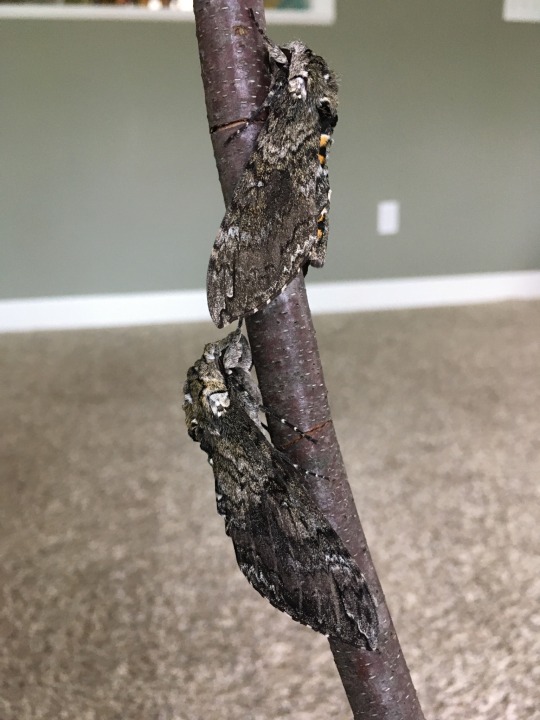
@crowned-frog-prince submitted: Hi! I'm from Michigan and recently the Hornworms I raised came out of their cocoons. I don't know what gender they are but the one on the bottom has very fluffy antenna compared to the other. I think they are five spotted hawk moths.
Hello! So nice they successfully emerged! These are actually Carolina sphinx moths (Manduca sexta) rather than five-spotted hawkmoths (Manduca quinquemaculata). They’re both in the same genus but the Carolina sphinx is much more common in Michigan. Carolina sphinx moths are called tobacco hornworms as caterpillars and they have a red horn on their butt. Five-spotted hawkmoths are called tomato hornworms and they have a bluish-black horn.
Here’s a five-spotted hawkmoth for comparison:

Similar pattern but not quite the same! Photo by gcwarbler
Anyhoo tell your lil moth pals I love them :)
121 notes
·
View notes
Photo

10/17 - Five-Spotted Hawk Moth
Good old Manduca quinquemaculata, the Tomato horn worm caterpillar that turns into a wonderful moth capable of hovering like a hummingbird! Don't let them ruin your tomato plants though.
#Inktober#Inktober 2019#inkcritters2019#hawk moth#tomato horn worm#can you believe I scanned and was ready to post and only then realized I forgot to paint the worm horn blue#I love these guys I have two pupating that will overwinter and hatch in the spring. they're gross but I love them!!!
8 notes
·
View notes